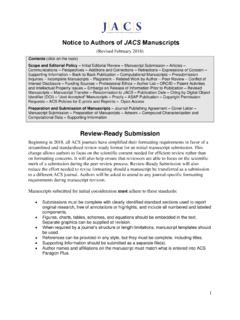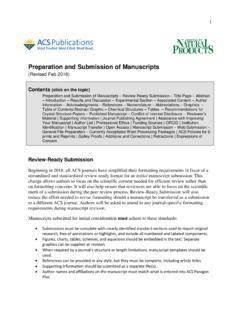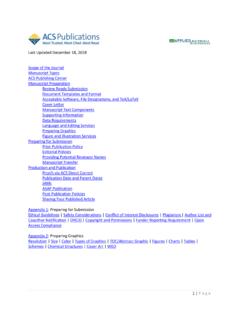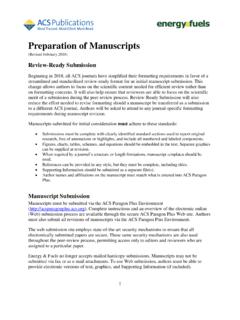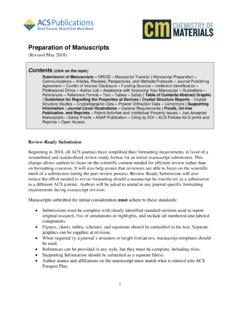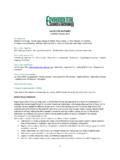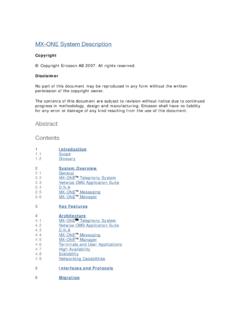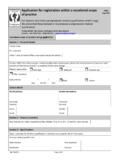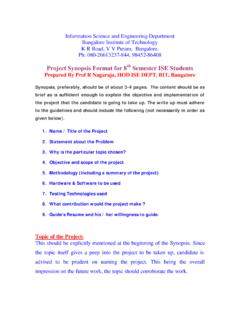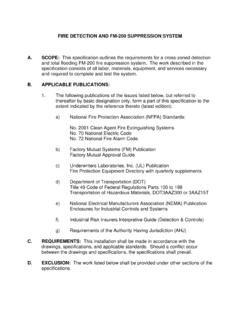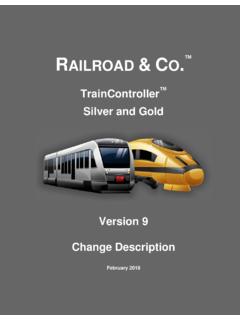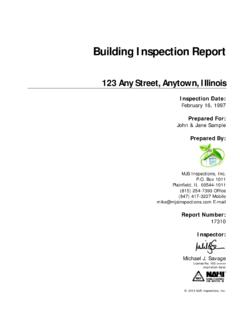Transcription of GUIDE FOR AUTHORS Updated February 2018 …
1 1 GUIDE FOR AUTHORS Updated February 2018 Journal scope Statement of scope - Article types: Research Article, Policy Analysis, Critical Review, Perspective, Correspondence/Rebuttal, Additions and Corrections, Feature, Viewpoint, and Letter to the Editor Manuscript eligibility ACS ethical guidelines - Prior publication policy - Resubmission of previously rejected manuscripts Manuscript preparation Formatting requirements - General style - Elements of a manuscript - Disclosures - Supporting Information - English language assistance Manuscript submission ACS Paragon Plus.
2 - Submission requirements, including file formats - Response to reviewers Post-submission processes Journal publishing agreement - Review process - Manuscript transfer process - Appeal process - Publication process - Additions and Corrections - Retraction Expressions of concern Frequently asked questions (FAQs) Note: Due to the volume of manuscripts we receive, ES&T is unable to accept pre-submission inquiries. Review-Ready Submission Beginning in 2018, all ACS journals have simplified their formatting requirements in favor of a streamlined and standardized review-ready format for an initial manuscript submission.
3 This change allows AUTHORS to focus on the scientific content needed for efficient review rather than on formatting concerns. It will also help ensure that reviewers are able to focus on the scientific merit of a submission during the peer review process. Review-Ready Submission will also reduce the effort needed to revise formatting should a manuscript be transferred as a submission to a different ACS journal. AUTHORS will be asked to attend to any journal-specific formatting requirements during manuscript revision. Manuscripts submitted for initial consideration must adhere to these standards: Submissions must be complete with clearly identified standard sections used to report original research, free of annotations or highlights, and include all numbered and labeled components.
4 Figures, charts, tables, schemes, and equations should be embedded in the text. Separate graphics can be supplied at revision. When required by a journal s structure or length limitations, manuscript templates should be used. References can be provided in any style, but they must be complete, including titles. Supporting Information should be submitted as a separate file(s). Author names and affiliations on the manuscript must match what is entered into ACS Paragon Plus. 2 3 Journal scope Statement of scope Environmental Science & Technology (ES&T) is the authoritative source of peer-reviewed research on topics related to human impacts on the environment and control methods designed to eliminate or reduce these impacts.
5 The journal advances rigorous scholarship on complex environmental phenomena, particularly with respect to fate, transport, and transformation in natural and engineered systems, while simultaneously facilitating the solution of critical environmental problems. In addition to novelty and significance of research, ES&T considers the relevance of submitted manuscripts to its readership. Prospective AUTHORS are encouraged to review recent issues of ES&T to gain an understanding of the topics that are of greatest interest to the journal s readers, and they are expected to establish in their cover letters the relevance of their submissions to the ES&T community.
6 Article types ES&T consists of two sections: research and front matter. The research section includes Research Articles, Policy Analyses, Critical Reviews, Perspectives, Correspondence/Rebuttals, and Additions and Corrections. Research section manuscripts are reviewed initially by the assigned editor and then, if appropriate, by other scientists who assess the significance, originality, and validity of the work. The Editor-in-Chief and associate editors, listed in the masthead, make final decisions about all research material published in ES&T.
7 The front matter section consists of Features, Viewpoints, and Letters to the Editor, along with Comments. The Managing Editor and Editor-in-Chief handle all front matter. Research Article (length limit: 7,000 word-equivalents). These papers concern the scientific understanding of natural environments and engineered environmental systems and technologies. ES&T has a focus on environmental processes, particularly those affected by human activities. This includes chemical, biological, and physical phenomena as well as mathematical and computational methods that are directly relevant to the understanding and management of the environment and pollution.
8 The journal also publishes articles that describe significant scientific advances or novel technologies for pollution remediation, control, and prevention. ES&T strives to publish novel research of scientific significance and environmental importance. Novelty is defined as new experimental data, new interpretations of existing data, or new analyses of environmental phenomena. Significance is judged with respect to the breadth of impact of the reported findings. Manuscripts that report data of a routine nature or that address topics that are already well understood will not be considered.
9 Whenever possible, research on new measurement technologies should include results with authentic environmental samples, and evaluations should be performed under environmentally realistic conditions. Manuscripts that report on initial findings of an urgent nature may be submitted to Environmental Science & Technology Letters (ES&TL). Manuscripts that are declined by ES&T should not be submitted to ES&TL without permission of the associate editor who handled the manuscript. Likewise, manuscripts declined by ES&TL should not be submitted to ES&T without the permission of the responsible ES&TL editor.
10 Policy Analysis (length limit: 7,000 word-equivalents). These manuscripts typically focus on the interface of science and engineering with public policy and provide new insight for understanding and managing human environmental systems. Topics of particular interest include risk assessment, critical evaluations of environmental regulations, and life-cycle analysis. Critical Review (length limit: 10,000 word-equivalents). These manuscripts are thoroughly documented, forward-looking assessments of particular areas in the environmental science and technology research domain.


